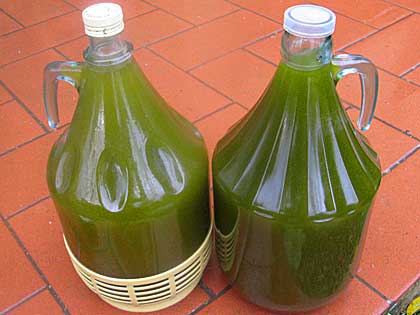Funny how it happens. Saffron, being that orange-yellow flavoring, food coloring, and dye made from the dried stigmas of a crocus, is required in enormous numbers of flowers to produce a small quantity of the large red stigmas used for the spice. The fragrant zafferano is native to Abruzzo, but oddly enough, it is hardly ever used in the region's local cuisine. The highly prized quality saffron–with its incredibly distinct flavor–is produced in the province of Aquila but is mostly exported to be processed and mixed with other types of a lesser quality elsewhere, because the are no local Abruzzi saffron refineries. Huh.

And so the unique goods growing on the slopes of the Abruzzi mountains end up being used for flavoring creamy Milanese risottos, delicious Spanish paellas and redolent French bouillabaisses.

The only local dish in which saffron is employed in Abruzzo, is the traditional "scapece" from Vasto, in the Chieti province.
The Vastesi are a gentle breed. You can be so bold as to tell them their brodetto fish stew is not the world's best (they'll smile feigning aloofness), but don't mess with their scapece, calling it bland. The dignified citizens of Vasto are very proud of their bold scapece. And rightly so.
Palates would have to be irreversibly tainted by fast– and processed foods not to notice this extraordinary dish. A triumph of flavors and redolent perfumes of the Mediterranean Sea fused into one terrific gran finale. A true taste bud surprise for even the most demanding and expert gourmand.
The traditional Vasto recipe is commonly handed down in families from generation to generation. And since I am now working here in the heart of Abruzzo, I thought I could share the recipe for scapece di Vasto.

And so the unique goods growing on the slopes of the Abruzzi mountains end up being used for flavoring creamy Milanese risottos, delicious Spanish paellas and redolent French bouillabaisses.

The only local dish in which saffron is employed in Abruzzo, is the traditional "scapece" from Vasto, in the Chieti province.
The Vastesi are a gentle breed. You can be so bold as to tell them their brodetto fish stew is not the world's best (they'll smile feigning aloofness), but don't mess with their scapece, calling it bland. The dignified citizens of Vasto are very proud of their bold scapece. And rightly so.
Palates would have to be irreversibly tainted by fast– and processed foods not to notice this extraordinary dish. A triumph of flavors and redolent perfumes of the Mediterranean Sea fused into one terrific gran finale. A true taste bud surprise for even the most demanding and expert gourmand.
The traditional Vasto recipe is commonly handed down in families from generation to generation. And since I am now working here in the heart of Abruzzo, I thought I could share the recipe for scapece di Vasto.
1 Kg (2.2 lbs) white fish (possibly thornback ray or smooth hound)
500 g (1.1 lbs) mixed mollusks and crustaceans
1 good pinch of saffron stigmas
1 cup fine quality white wine vinegar
1 small white onion, finely chopped
2 fistfuls of all-purpose flour
Salt
Olive oil for frying
A chilled bottle of Trebbiano d'Abruzzo
Clean and gut the fish and then cut it into small chunks. Trim and clean the octopus and other mollusks, and remove the carapace from the shrimp. Cut these in small pieces too and roll it all in the flour, fry in a skillet for about 3 minutes, and then park briefly on a paper towel to absorb excess grease.
Warm the vinegar over a mild flame, remove the pot from the stove just before it boils, and break the saffron filaments into it.
Sweat the chopped onion in some olive oil, and set aside when translucent.
Make layers of the fried mixed fish chunks in a high rimmed container (preferably glass) dousing them with the warm aromatic vinegar, drench each layer with a splash of Trebbiano and some sautéed onions. Marinade for 8 days, at least, and then serve like the Vasto fisherman would, with crusty bread, a seaside view and good conversation. Don't forget the leftover Trebbiano...
Buon appetito.
500 g (1.1 lbs) mixed mollusks and crustaceans
1 good pinch of saffron stigmas
1 cup fine quality white wine vinegar
1 small white onion, finely chopped
2 fistfuls of all-purpose flour
Salt
Olive oil for frying
A chilled bottle of Trebbiano d'Abruzzo
Clean and gut the fish and then cut it into small chunks. Trim and clean the octopus and other mollusks, and remove the carapace from the shrimp. Cut these in small pieces too and roll it all in the flour, fry in a skillet for about 3 minutes, and then park briefly on a paper towel to absorb excess grease.
Warm the vinegar over a mild flame, remove the pot from the stove just before it boils, and break the saffron filaments into it.
Sweat the chopped onion in some olive oil, and set aside when translucent.
Make layers of the fried mixed fish chunks in a high rimmed container (preferably glass) dousing them with the warm aromatic vinegar, drench each layer with a splash of Trebbiano and some sautéed onions. Marinade for 8 days, at least, and then serve like the Vasto fisherman would, with crusty bread, a seaside view and good conversation. Don't forget the leftover Trebbiano...
Buon appetito.



























































